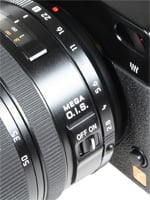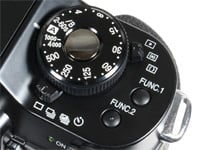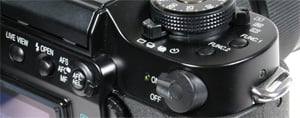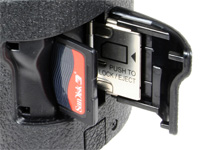Panasonic Lumix DMC-L1
-
-
Written by Gordon Laing
Panasonic DMC-L1 design and controls
| Support this site by shopping via these links |
The Panasonic Lumix DMC-L1 is certainly no traditional-looking digital SLR. Clearly inspired by Leica’s classic M-Series rangefinders, the L1 stands out from the crowd and will greatly appeal to enthusiasts who look back fondly on analogue designs. The L1’s not just about nostalgia though, as its analogue control system provides genuine benefits we’ll discuss later.
The Lumix L1’s pictured above and below with its ‘kit’ Leica 14-50mm lens, alongside the Nikon D80 and Nikkor DX 18-70mm. Measuring 146x87x80mm and weighing just over a kilogram with the lens, the L1’s shorter, but wider and heavier than most DSLR kits. The most obvious difference when viewed from the front is the absence of the traditional penta-prism / penta-mirror head – indeed it looks like it’s been sliced clean off to give a completely flat upper surface.
This approach follows the earlier Olympus E-330 and indeed the L1 shares the same sensor, shutter and mirror assembly – so like the E-330, the L1 flips its mirror sideways rather than upwards. This results in the L1’s viewfinder being located to the left side of the lens axis, as seen in the view below. It also allows the L1 to feature a flat upper surface which lends it an appearance closer to a rangefinder than a DSLR. Panasonic’s also fitted the AF-assist lamp in the top right corner where a rangefinder viewfinder window would normally be found.
The view above also clearly reveals the L1’s grip as considerably smaller than a modern DLSR. This again follows the rangefinder inspiration, and while there’s obviously less to wrap your fingers around, you can still hold the L1 both comfortably and securely. The L1’s rubber coated magnesium alloy body also feels very solid and built to a high standard, roughly equivalent to higher-end DSLRs like the Canon EOS 30D. The L1’s design will undoubtedly polarise opinions and you’ll either love or hate it. Either way, there’s no denying it’s an original concept, and personally speaking we reckon it’s a classy-looking camera, and much more appealing than the Olympus E-330.
 | |
The Lumix L1’s exterior design is about more than just rangefinder styling though: it shuns many modern electronic controls in favour of older analogue alternatives. There may be a dial on the upper right surface, but instead of selecting an exposure mode, it’s dedicated to adjusting the shutter speed. And close to the body around the lens barrel is a mechanical aperture ring – the mere mention of which will be enough to get many enthusiasts going.
And for good reason too: aperture rings and shutter dials offer quick and easy ways to set the exposure and f-number without reading manuals, pressing buttons or peering at a screen. Panasonic’s also used them to implement a neat way of switching between exposure modes. Both the shutter dial and aperture ring feature A settings, and if both are set to these positions, the L1 operates in Program mode.
If you turn either the Aperture ring or Shutter dial though, the L1 switches into Aperture or Shutter Priority respectively (both adjustable in one third EV increments). Turn both away from their A settings and you’re in full Manual. After using the L1 for a short while, you wonder whether the almost universal switch to electronic control of shutter and aperture was such a good idea after all.








